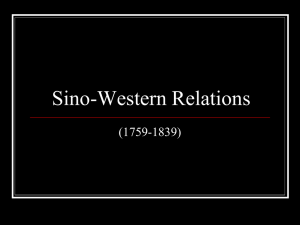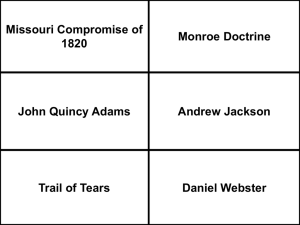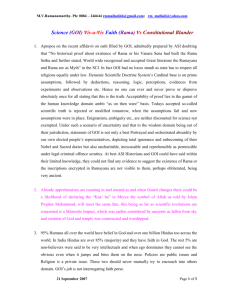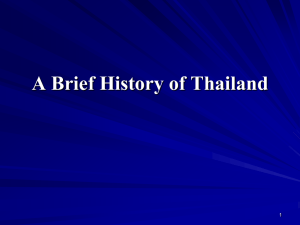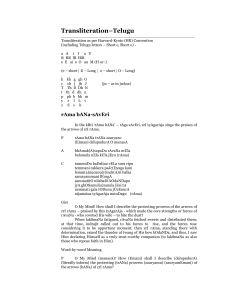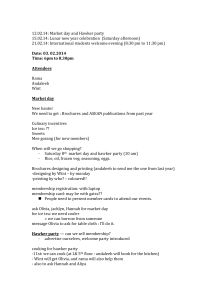thailand socio-econ development
advertisement
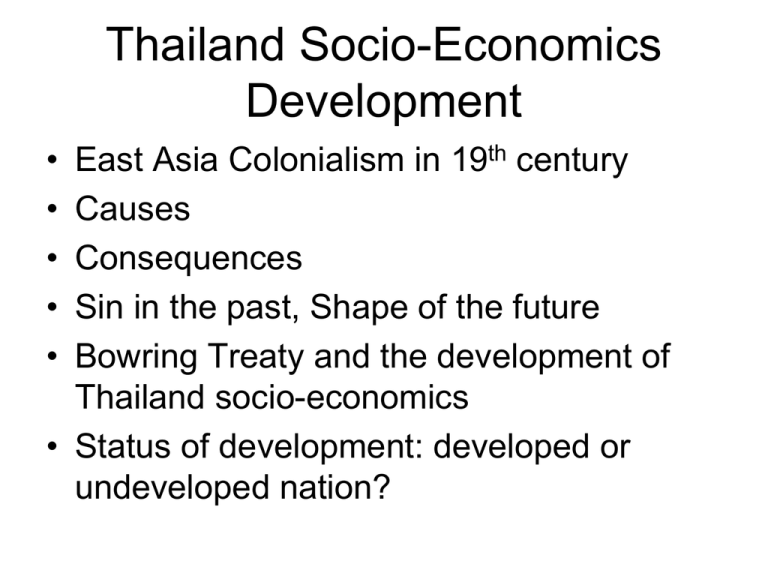
Thailand Socio-Economics Development • • • • • East Asia Colonialism in 19th century Causes Consequences Sin in the past, Shape of the future Bowring Treaty and the development of Thailand socio-economics • Status of development: developed or undeveloped nation? Portuguese expeditions 1415–1542: Portuguese spice trade routes in the Indian Ocean Imperialism and Capitalism • • • • the highest (advanced) stage of capitalism Lenin(1817) The essay is a synthesis of Lenin’s modifications and developments of economic theories had formulated and became Karl Marx Das Kapital (1867). Capitalism required monopolies (of labour and naturalresource exploitation) and the exportation of finance capital (rather than goods) to sustain colonialism Under Lenin or Marx idea, in the capitalist homeland, the profits yielded by the colonial exploitation of a people and their economy, permit businessmen to bribe native politicians, labor leaders and the labor aristocracy (upper stratum of the working class) to politically thwart worker revolt (labor strike). China as a Center of Civilization • Massive Population – Growing population, large work force, need no industrialization • Advanced Civilization – Inventor (compass, gun powder) and producer of fine goods by skilled artisan (porcelain) • Control local and international trade – government monopolized trade “Canton System” • Very long History => Cultural Chauvanism – Superior to other countries – As a consequence: unwilling to learn from others European Trade and China • Europe wish to access to Chinese markets • Europe wanted most of Chinese items more than China wanted from Europe • China wanted trade settlement in gold or silver only • Britain solved trade imbalance problem by opium as a payment instead of gold/silver พระนางซูสีไทเฮา แห่งราชวงศ์ชิง Empress Dowager Cixi, Qing Dynasty, was a powerful and charismatic woman who effectively controlled the Chinese government from behind the bamboo curtain for 47 years, from 1861 to her death in 1908. จักรพรรดิปยู แี ห่งราชวงศ์ชิง (1644 - 1911) The Last Emperor Puyi of Qing Dynasty Treaty of Nanjing: Consequence of 1st Opium War Treaty of Tein Sin: Consequence of 2nd Opium War Why China lost to Western? • Technology is the key • Both opium wars were determined on the sea • Firearms outright swords, arrows and extend the distance of the front line • Number of soldier was un-necessary winning factor • Economic aspect of Technology: Division of labor => Expertise โทกุงาวะ โยชิโนบุ โชกุนคนสุ ดท้าย Tokugawa Yoshinobu, the last Shogun ไซโงะ ทะกะโมริ (西郷 隆盛 ), 1828 – 1877 และ นาย พลเรื อเพอร์รี่ ผูน้ าการเปลี่ยนแปลงมาสู่ญี่ปุ่น Young Patriots in Satsuma 46 people gathered in Nagasaki with Saigo's command, 1865. Photo by Hiroma Ueno Saigō Takamori Gunmusho (軍務 所) banknote, issued in 1877 to finance his war effort จักรพรรดิเมจิ Emperor Meiji จักรพรรดิไทโชและจักรพรรดิ์ฮิโรฮิโตะ Emperor Taisho and Hirohito การใช้ทหารแทนซามุไร Colonialism: Thailand and Japan • Trade openness (trade liberalization) is a new form of colonialism in 19th century • Both faced the same situation in dealing with western influences calling for open their countries to trade • India and China are the good example of closed and under-progressed economy that can not resist the western modernization influences • Modernization or Internationalization usually refers to progress and/or development such as; – Western style clothes or eating (cultures) – Constitution (politics) – Capitalism (economics) Bowring Treaty (1855-1916) การแต่งกายชาวจีน สมัย ร.5 King Chulalongkorn 1868-1910 Selected Chronology of Western Influences in East Asia Year Events Consequences 1840 First Opium War Britain and China 1853 U.S. first arrived in Japan 1855 John Bowring Thailand 1856 Second Opium War between Tianjin Treaty 1858 British and China 1858 U.S. second arrived in Japan 1868 Meiji and Chulalongkorn took started of Meiji Restoration (1868reign 1912) and Chakkri Reformation (1868-1910) between Nanjing Treaty 1842 arrived U.S.-Japan Treaty of Peace and Amity 1854 in Treaty of Friendship and Commerce between Siam and Great Britain 1856 U.S.-Japan Treaty Commerce 1858 of Amity and Chakkri dynasty King known as period of reign Rama I Yodfah 1782-1809 Rama II Lertlah 1809-1824 Rama III Nang Klao 1824-1851 Rama IV Mongkut 1851-1868 Rama V Chulalongkorn 1868-1910 Rama VI Vajiravuhd 1910-1925 Rama VII Prajadipok 1925-1935 Rama VIII Ananda-Mahidon 1935-1946 Rama IX Phumiphon-Aduldet 1946-present Socio-Economic Development • Under the Bowring Treaty end of state trade monopoly • International division of labor lack of entrepreneur class less saving lead to lack or depend on foreign technology



